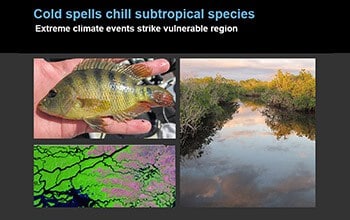Two cold spells, two years apart, in two subtropical regions of the world have given scientists clues about what happens when an extreme climate event strikes.
By tracking conditions before, during and after a 2008 cold spell in China and a 2010 cold spell in Florida, researchers found chilling effects on plants and animals, but not all the effects were equal.
Tropical species suffered more than their temperate counterparts, which were able to resist and recover from the record low temperatures.
Complex consequences
“Long-term ecological studies like these give us opportunities to understand the complex consequences of unanticipated events such as extreme cold snaps,” said ecologist Evelyn Gaiser of Florida International University and principal investigator of the National Science Foundation (NSF) Florida Coastal Everglades Long-Term Ecological Research (LTER) site, one of a network of NSF LTER sites. “This short but extreme cold event mimicked the effects of a strong tropical storm or hurricane. The short-term consequences were different but the long-term conclusions were similar.”
In South Florida, tropical fish populations declined, while populations of their temperate counterparts remained unchanged or increased following the 2010 cold spell.
Tropical American crocodiles declined, while temperate American alligators weathered the cold. Tropical mangroves died while temperate saltmarsh grasses survived.
In China, the population of tropical butterflies in the Nanling National Nature Preserve dropped by 80 percent following the cold spell there, allowing temperate butterflies to dominate the area for two years.
New insights
Florida researchers, along with others in the United States and China, have been conducting long-term research programs in these two regions.
With historic data in hand, they were able to act quickly when the cold snaps arrived — evaluating conditions and local plants and animals long after temperatures returned to normal.
Their efforts are shared in a new, special issue of the journal Ecosphere, published by the Ecological Society of America.
“More frequent extreme weather is likely with climate change,” said David Garrison, program director in NSF’s Division of Ocean Sciences, which co-funds the LTER Program with NSF’s Division of Environmental Biology. “These studies show that these extremes may be cold anomalies as well as warm ones.”
Effects on species
Along with disrupting biodiversity, the 2010 cold spell affected Florida’s fisheries.
Economically lucrative bonefish, snook and goliath grouper fisheries experienced mass mortalities, while others, including red drum and gray snapper, were not affected.
Some saw population increases after the cold spell passed, including redfish.
Non-native species proved to be less resistant to the cold spells than native species. Non-native bee populations in South Florida took nearly four years to recover, and some non-native fish have shown no meaningful population recovery to date.
The researchers stress the importance of using long-term data to understand how these species in the subtropics will react to and recover from extreme climate events, and to predict what the future will look like for them.
Not all populations resist and recover equally, scientists say, and conservation plans that incorporate strategies for extreme climate events could help those that are most vulnerable.


